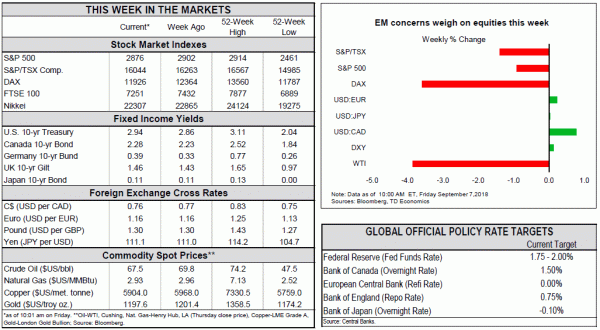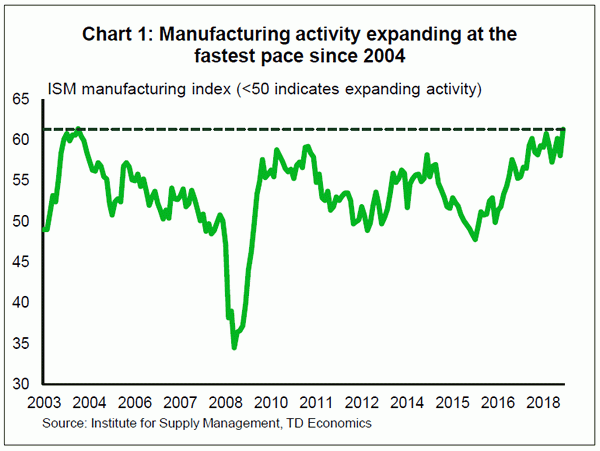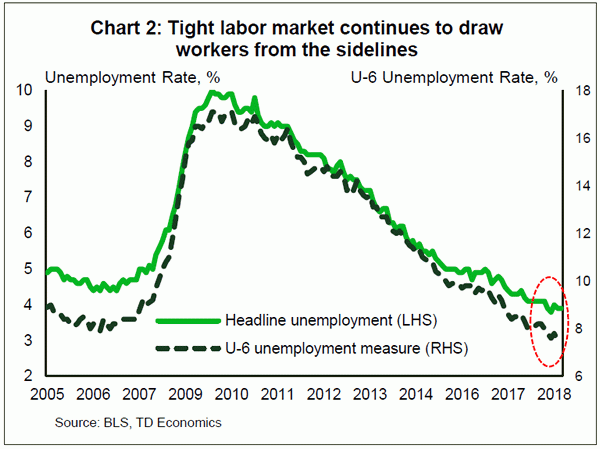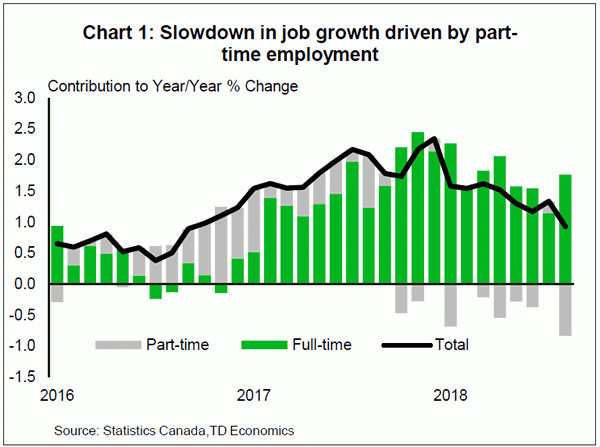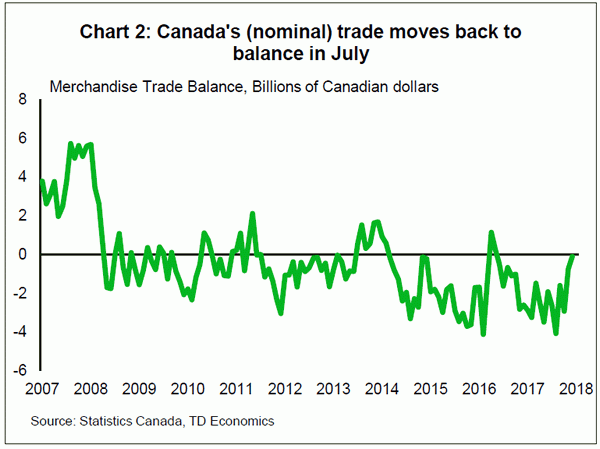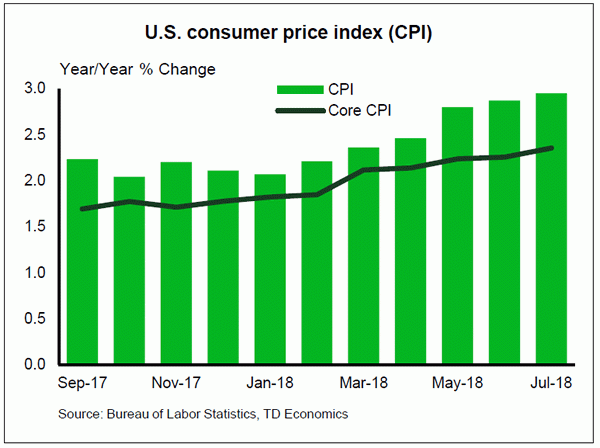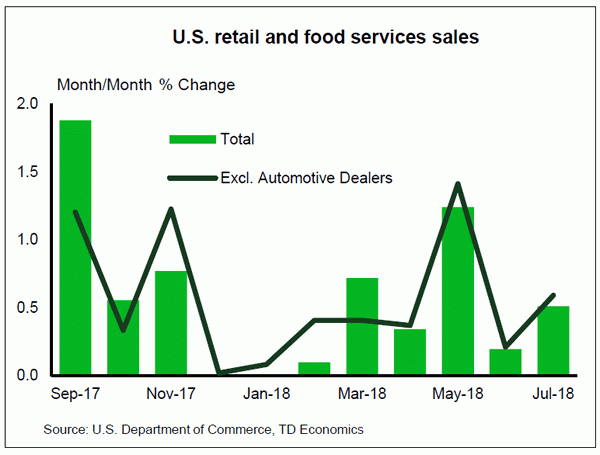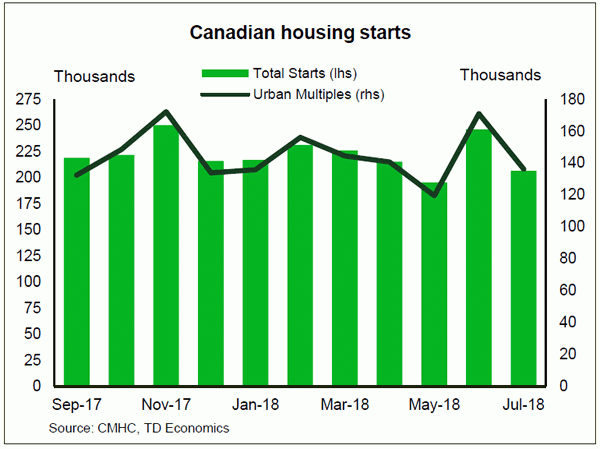U.S. Highlights
- Concerns about emerging markets continued to weigh on investor sentiment this week, with the selloff in EM assets and currencies spreading beyond Turkey and Argentina.
- Meanwhile, domestic data remained positive. ISM indices for both manufacturing and services sectors rose handsomely in August. The payroll report delivered another batch of good news with 201k new jobs created on the month and wage growth accelerating.
- All told, the U.S. economy continues to boom, giving the Fed little reason to alter its interest rate normalization plans that include another increase on September 26th.
Canadian Highlights
- As expected, the Bank of Canada left the overnight rate at 1.5%. Its accompanying statement was generally upbeat, noting positive developments on both external and domestic fronts.
- A follow up speech by Senior Deputy Governor Wilkins noted Canada’s resilience, but also emphasized the Bank’s focus on monitoring economic data and the impact of trade developments on the inflation outlook.
- Canada’s job market took a step back in August, shedding 51.6k jobs, all them part time (-92k). The unemployment rate rose to 6.0% from 5.8% in July.
U.S. – Summer’s Ending, But the U.S. Economy Still Shines
Trade developments and payrolls stole the limelight in this busy, holiday-shortened week. Concerns about emerging markets continued to weigh on investor sentiment with the selloff in EM assets and currencies spreading further beyond Turkey and Argentina. Meanwhile, the increased risk of another round of economic sanctions has sent the Russian ruble lower.
While selling pressure eased somewhat by the week’s end, headwinds battering emerging markets are unlikely to dissipate soon. U.S. expansionary fiscal policy is buoying domestic growth, putting upward pressure on the dollar, inflation, and interest rates. At the same time, trade spats with China and other U.S. trade partners are weighing on overseas currencies and global growth. As a result, dollar strength coupled with worries about trade should continue to fuel investor flight from emerging markets.
Meanwhile, if cracks are appearing in U.S. business confidence, they were nowhere to be found in the August data. ISM indices for both manufacturing and services sectors rose handsomely (Chart 1), suggesting that U.S. industries remain at the top of their game. Even as tariffs continue to raise costs and play havoc with supply chains, companies report rising new orders and expanded production on the back of solid domestic demand that offers a deep cushion against potential tariff impacts.
Strong sentiment and economic momentum is boosting hiring, as evidenced by today’s payroll report, which showed that 201k new jobs were created in August. With the jobless rate hovering at historic lows, it is becoming increasingly difficult to find workers to fill positions. This continues to draw in workers from the sidelines (Chart 2) and also motivating firms to raise wages. As a result, the closely watched average hourly earnings measure rose 0.4% in August, accelerating to 2.9% on a year-over-year basis. This is the fastest pace of wage growth of the recovery, and may prove to be the start of the long-awaited sustained pickup in wage growth.
Clearly the U.S. economy is barreling full steam ahead, and the estimated impact of tariffs has so far been quite small. The $50 bn in import tariffs on China and the steel and aluminum tariffs may shave roughly 0.2 ppts off U.S. real GDP growth in about years’ time, and add two tenths of a point to inflation. However, as we note in our report, the tariffs in place are only the tip of the iceberg relative to those under review or threatened. So far the U.S. has levied tariffs on $107 bn of imports into the U.S., but the total tariff action under consideration amounts to $715 bn. If implemented, they could place about 1.2 ppts of U.S. and 0.4 ppts of global growth at risk.
All told, an escalation in the trade spat with China and waning global demand may yet test the durability of the current expansion. However, for now the U.S. economy continues to boom with little reason for the Fed to alter its interest rate normalization plans that include another quarter point increase on September 26th.
Canada – A Resilient Economy Beset By Risks
It was a busy week for Canadian economy watchers. Between a Bank of Canada announcement and a speech by Senior Deputy Governor Wilkins, analysts were also treated to July trade data and an August jobs report. Meanwhile, NAFTA negotiations continued, with both sides noting progress, but no deal yet.
As expected, the Bank of Canada left its key lending rate unchanged on Wednesday. The content of its statement, however, could just as easily have accompanied a rising rate announcement. In terms of external developments, it noted ongoing progress in global growth and particularly robust growth stateside. Domestically, it acknowledged positive business investment and export growth (July saw the smallest trade deficit since late 2016), in spite of uncertainty around trade policy. And finally, on the housing front, the Bank noted a stabilization in activity alongside a welcomed slowdown in credit growth.
The positive tone of the statement was reinforced in a follow up speech entitled “An Update on Canada’s Economic Resilience.” As noted in the title, Canada’s economy has continued to operate close to potential despite numerous headwinds. Having bounced back solidly from the commodity-rout, it has also withstood trade uncertainty with relative gusto. Still, Wilkins was careful to recognize the negative impact of trade uncertainty and that this is something that is not easily accounted for in the Bank’s economic models, requiring ongoing monitoring and additional focus on corroborating evidence.
Wilkins also spent some time unpacking inflation developments. Headline inflation has risen to 3%, but this has been largely due to temporary factors – rising energy prices and a surge in airline prices. Core inflation measures, meanwhile, have trended right around the Bank’s 2% mark, showing few signs of breaking higher or risking that the Bank has fallen behind the curve.
On this point, perhaps the part of the speech to get the most attention was the discussion of the “gradual” characterization of future policy. Wilkins noted that the Governing Council had discussed whether the term was still appropriate, given Canada’s cited resilience. Ultimately, with the rise in inflation looking temporary and uncertainty around trade continuing to be a factor, the Bank of Canada opted to retain its “gradual” language.
A gradual approach may also be prudent given the inherent volatility in Canadian economic data. Canada’s job market pulled back in August, shedding 51.6k jobs, all of them part-time (-92k) and nearly all of them in Ontario (-80.1k). On a longer-term basis, the pace of job growth at 0.9% year-on-year seems just about right for an economy operating near potential.
All told, developments this week put an exclamation point on our expectation for an October rate hike. Following that, we think we are likely to move back into wait and see mode – with trade evelopments front and center to future Bank of Canada decisions.
U.S.: Upcoming Key Economic Releases
U.S. Consumer Price Index – August
- Release Date: September 13, 2018
- Previous: 0.2% m/m, 2.9% y/y; core 0.2% m/m
- TD Forecast: 0.3% m/m, 2.8% y/y; core 0.2% m/m
- Consensus: 0.3% m/m, 2.8% y/y; core 0.2% m/m
We expect CPI to moderate to 2.8% from this July peak, reflecting a 0.3% m/m gain boosted by gasoline prices and a solid core. We eye weakness in food prices on the back of the tariff-induced slowdown in agricultural prices which have depressed producer-level prices. Outside of food and energy, we look for core CPI to print a strong 0.2% m/m, keeping core inflation at 2.4%. Underpinning another strong read are goods prices, held higher in particular by a rebound in apparel and further gains in auto prices. Recent industry analyst reports continue to emphasize record higher vehicle prices while building momentum in import prices suggests scope for high import content products like apparel to post gains. As in July we will continue to watch for ongoing tariff impacts from steel/aluminium and those imposed on China, which have not yet been noticeable. Looking ahead we continue to expect headline inflation to slide further into yearend as base effects from gasoline prices dissipate.
U.S. Retail Sales – August
- Release Date: September 11, 2018
- Previous: 0.5%, 0.6% ex-auto, 0.5% control
- TD Forecast: 0.5%, 0.8% ex-auto, 0.5% control
- Consensus: 0.6%, 0.6% ex-auto, 0.5% control
We expect a strong retail sales report with headline sales rising 0.5% in August. Auto sales are a drag this month but elsewhere we eye gains across gasoline stations (helped by higher gasoline prices), restaurants (warm weather) and the broader control group. The latter is expected to post a 0.5% increase. The August read would be consistent with Q3 real PCE at a solid rate near 2.5-3%, underpinning Q3 GDP tracking north of 3%.
Canada: Upcoming Key Economic Releases
Canadian Housing Starts – August
- Release Date: September 11, 2018
- Previous: 206.3k
- TD forecast: 225k
- Consensus: NA
We look for a sizeable rebound in August housing starts to 225k, slightly above the 6-month average and following a 206k pace in July. This would be consistent with the trend in building permits which have maintained a steady uptrend since late 2017. In the details we expect increases in both single- and multi-unit starts. The former in particular hit a more than 3-year low in July whereas permit issuance picked up in the summer months, pointing to a rebound. Overall, the August rebound if realized would leave housing construction tracking fairly solid into Q3 but further out we continue to expect a gradual moderation closer to a 200k pace, consistent with a rising rate environment.




